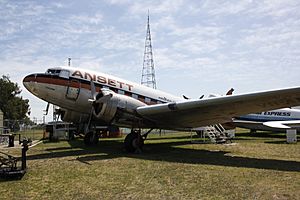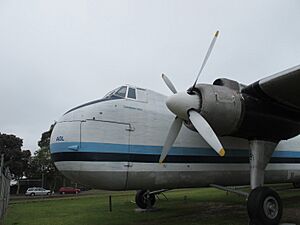Australian National Aviation Museum facts for kids
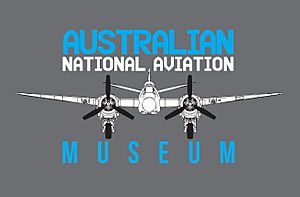 |
|
| Lua error in Module:Location_map at line 420: attempt to index field 'wikibase' (a nil value). | |
| Established | 1962 |
|---|---|
| Location | Melbourne, Victoria, Australia |
| Type | Aerospace |
The Moorabbin Air Museum is an exciting aviation museum located at Moorabbin Airport in Melbourne, Victoria, Australia. It began in 1962 as the Australian Aircraft Restoration Group. The group's main goal was to save a World War II Bristol Beaufighter aircraft. Since then, it has grown into a large museum with many different aircraft. Until October 2021, it was known as the Australian National Aviation Museum. As of 2021, the museum had almost 60 aircraft and 25 engines.
History of the Museum
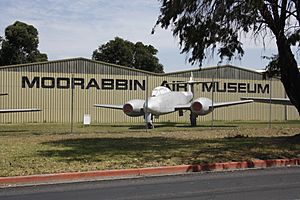
How the Museum Started
The Australian Aircraft Restoration Group was formed in 1962. It was a group of volunteers who loved aviation. Many members were also part of the Aviation Historical Society of Australia.
Early Homes for the Collection
At first, the museum's aircraft were kept on a farm in Wandin North. Then, they moved to the Pine Hill Service Station near Lillydale. A Wackett trainer plane, donated by the Lucas family, was proudly displayed there. In 1965, land was set aside for the museum at Moorabbin Airport in Victoria.
Growing the Aircraft Collection
In the early days, the collection included planes owned by private people and planes the museum bought itself. One of the first planes saved was a DAP Mark 21 Bristol Beaufighter (A8-328). This plane used to belong to the Royal Australian Air Force (RAAF). It was being used as playground equipment and was almost scrapped. The Beaufighter was donated in April 1962.
After that, the Lucas family donated a CAC Wackett. Then came the oldest complete aircraft in the collection, a De Haviland DH.60G Gypsy Moth.
Busy Year of 1963
The year 1963 was very busy for the group. In January, they bought an Avro Anson (VH-FIA) from Flinders Island Airlines. In May, they got a Gloster Meteor from the Department of Supply. Trans Australia Airlines (TAA) gave them a de Havilland Tiger Moth in mid-1963. The year ended with them finding a CAC Wirraway at a dump near East Sale RAAF base.
Moving to Moorabbin Airport
In early 1964, most of the planes moved to a service station north of Lilydale. The Wackett was displayed there until it moved to Moorabbin. Later that year, many aircraft were taken to a market garden next to Moorabbin Airport. In October 1964, a Percival Proctor was donated. By this time, the Department of Civil Aviation agreed to let the group lease land at Moorabbin Airport. A fence was put up on May 20, 1965.
More Aircraft Join the Museum
In 1966, the group went back to a farming area near Colac. They collected a Curtiss Kittyhawk fuselage. February 1967 saw a very exciting arrival. A former Royal Australian Navy (RAN) Fairey Firefly was flown all the way from Bankstown in New South Wales to Moorabbin.
For the next 20 years, the museum grew. More and more aircraft joined the collection. The museum quickly decided that any aircraft or item they got had to be important to Australian aviation history. This helped the museum keep its collection focused and meaningful. Other aviation museums started in Australia, but none collected such a wide range of aircraft types, all connected to Australian history. The collection includes everything from gliders and home-built planes to World War II combat aircraft, jet fighters, crop dusters, and large four-engine airliners.
Protecting the Collection
Challenges of Outdoor Displays
By the early 1980s, the aircraft collection had grown to an impressive 30 planes. However, the museum learned a tough lesson. Just collecting, restoring, and displaying aircraft was not enough. At this time, the museum was still an open-air display. Being outside in the weather started to damage the aircraft. Even strong planes will eventually get ruined if they are left out in the open.
Building Hangars for Protection
During the 1970s and 1980s, there were many ideas from the government and private groups to fund a National Aviation Museum in Victoria. The Moorabbin Air Museum was part of many of these discussions. But by the late 1980s, it became clear that none of these plans would happen. The museum directors realized that they had to act themselves to save the aircraft for the long term.
In 1988, the museum sold some of its extra items to get money. This money was used to build an 8,000-square-foot hangar on the museum site. This hangar was finished in April 1989. Three years later, it was made even bigger, to 12,000 square feet. Over the years, a library, workshop, storage area, and an entry building with a shop were also built.
Museum Achievements and Future Plans
The Moorabbin Air Museum has received several awards over the years. The most important was a Certificate of Merit in the 1985 Museum of the Year Awards. Besides saving aircraft, the museum has also helped many young members. They have gone on to have careers in aviation or museum work. The experience they gained at the museum helped them greatly in their jobs.
Many people might think the museum has reached its goals, but it is still growing. Between 1980 and 2000, the aircraft collection grew by about one plane each year. The museum now has 52 aircraft. This makes it the largest aircraft owner at Moorabbin Airport. It has more planes than half of the world's airlines and a third of the world's air forces. However, only one-third of these planes are displayed indoors. The rest are in storage, on loan, being restored, or, at worst, still displayed outside.
In September 2021, the museum was given a lease for land across from its current site. This increased its total size by about 4000 square meters. A new building will be constructed there as part of the Community Heritage Precinct. This new facility will finally allow all aircraft to be undercover and protected for the first time in the museum's history.
Aircraft in the Collection
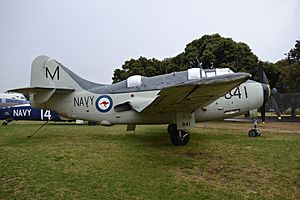
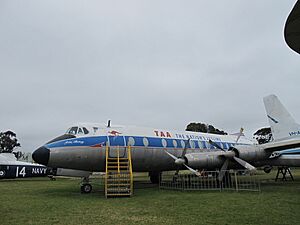
| Aircraft Type | Operator/s | Number |
|---|---|---|
| CA-27 Avon Sabre | RAAF | A94-910 |
| CAC CA-12 Boomerang | RAAF | A46-25 |
| CAC CA-31 Operational Trainer (mock-up) | RAAF | |
| CAC CA-28 Ceres | VH-WOT | |
| CAC CA-6 Wackett | RAAF | A3-22 |
| CAC CA-25 Winjeel | RAAF | A85-418 |
| CAC CA-1 Wirraway | RAAF | A20-10 |
| Royal Aircraft Factory B.E.2a (wings only) | RAF | |
| DAP Bristol Beaufort MK V | RAAF | A9-13 |
| GAF Jindivik | RAAF | A92-492 |
| Avro Lincoln | RAF | RF342 |
| Dassault Mirage IIIO | RAAF | A3-45 |
| General Dynamics F-111 (cockpit) | RAAF | A8-131 |
| Bristol Type 171 Sycamore | RAAF | A91-1 |
| Consolidated PBY Catalina | RAAF | A24-88 |
| Curtiss P-40E Kittyhawk (under restoration) | RAAF | A29-53 |
| de Havilland Tiger Moth | RAAF/TAA | A17-377 |
| de Havilland Sea Venom | RAN | N4-901 |
| Fairey Firefly | RAN | WD827 |
| Fairey Gannet A.S.4 | RAN | XG789 |
| Gloster Meteor T7 | RAAF | A77-707 |
| Miles M-38 Messenger 2A | VH-AVQ | |
| Bristol Type 170 Freighter | Pakistan Air Force/Air Express | VH-ADL |
| Douglas DC-2 | Eastern Air Lines/RAAF/ANA/Ansett Australia | NC13782 / A30-9 / VH-CRK |
| Douglas DC-3 | USAAF/RAAF/ANA/Ansett Australia | VH-ANH (VHCDJ) |
| Vickers Viscount V.816 | Cubana de Aviación/Trans Australia Airlines | VH-TVR |
| Auster J-1B Aiglet | VH-ACY | |
| British Aircraft Swallow II | VH-UUM | |
| Cessna 310 | VH-AER | |
| de Havilland Heron | Airlines of Tasmania | VH-CLX |
| de Havilland Gypsy Moth | VH-UKV | |
| Desoutter Mk.II | VH-UPR | |
| Duigan pusher biplane(Replica) | VH-DGN | |
| Percival Proctor | VH-AUC | |
| Boeing 737 (forward fuselage) | US Air | RP-C8006 |
| Victa Airtourer 100 | Aero Club of South Australia | VH-BWI |
| Douglas DC-2 (in storage) | KLM | Unknown Registration |
| English Electric Canberra | RAAF | A84-226 |
| Pazmany PL-4 | VH-XAP | |
| GAF Nomad | Royal Australian Air Force | A18-316 |
| Aerospatiale Dauphin II | Victoria Police | VH-PVF |
See also
- List of aerospace museums


